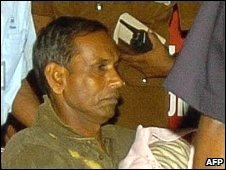 Two senior Tamil Tiger rebels in Sri Lanka have surrendered to the military, the army says.
Two senior Tamil Tiger rebels in Sri Lanka have surrendered to the military, the army says.
It says that the rebels’ media co-ordinator, Daya Master, gave himself up along with a top interpreter, named George, who worked for senior rebels.
Correspondents say that if the reports are true it will be a major setback for the rebel leadership.
It has insisted that rebels should commit suicide by swallowing cyanide capsules rather than be captured.
The army says that the pair were taken at Puthumathalan on Wednesday "in the company of fleeing civilians".
Sri Lankan military spokesman Brig Udaya Nanayakkara said Daya Master was the most senior rebel official to surrender so far.
The rebels are surrounded by the army in a small area of land in the north-east of the country. The Tigers have not yet commented on the army’s claims.
Translator
The military website says that Daya Master played a significant role in the rebel outfit and was their media spokesman for the past few years.
It says that his decision to turn himself in will come as "a rude shock" to rebels and "expatriates who have been pumping hard currency into their coffers".
The army says the other man who gave himself up, George, was the translator for senior rebel leader SP Thamilselvan, who was killed in an air strike in 2007.
The army also says that the number of Tamil civilians who have escaped from areas held by Tamil Tiger rebels in northern Sri Lanka has risen to 77,000.
A spokesman said soldiers had taken control of "10 to 15%" of the last remaining territory held by the rebels.
The Tamil Tigers were trying to move their leader Prabhakaran to a safe haven, the spokesman said.
‘Increasing casualties’
The US state department has meanwhile released satellite images of civilian camps consisting of 25,000 tents in a government-designated safe zone – which the army says will not be attacked by heavy armaments – in the dwindling amount of territory still held by the rebels.
The images show the area before the camps were established and after displaced people moved in.
The state department says 120,000 people remain in the war zone.
"There continues to be firing from both sides into the no-fire zone, and we have credible reports of increasing casualties as a result," department spokesman Robert Wood told reporters.
The Sri Lankan government says that about 30 civilians have been killed in the past 48 hours, including 17 in a rebel suicide attack.
The rebels said the army had killed about 1,000 civilians in the latest fighting.
The pro-rebel TamilNet website accused the government of releasing "contradictory figures" in relation to the number of civilians who have fled the war zone.
There is no confirmation of either side’s claims, but the UN estimates that more than 4,500 civilians have been killed in the past three months.
Satyamurthi, a doctor who works at a hospital in Matthalan, told the BBC thousands of civilians had tried to take shelter in a church compound.
Dr Satyamurthi said the main priest, Father James Ferdinand, was injured by shellfire and three civilians were killed.
"Some [civilians] tried to escape towards the Mullaitivu area, others don’t know where to go, they want to stay in the church here. But many, many others are staying outside and are vulnerable," the doctor said.
Brig Nanayakkara told the BBC that the army had "rescued" 77,000 people since Wednesday.
"Some people have been evacuated, while others have wanted to stay with government troops," Brig Nanayakkara said.
He denied the army was responsible for civilian deaths.
"We are not targeting the civilians. The rebels are causing civilian casualties," he said.
The head of the Sri Lankan army, Lt Gen Sarath Fonseka, told the BBC that troops knew the "general area" of Tamil Tiger leader Velupillai Prabhakaran and that "action will be taken to destroy him".
Prabhakaran was hiding near the coast, Lt Gen Fonseka said.
Troops believe he could try to escape the war zone by boat, a method used by other rebel leaders.
The general said only 300-400 Tamil Tiger fighters remained, but there may be 700 "forcibly armed" people in rebel bunkers.
The government has said that a pause in fighting is not necessary because additional consignments of food, medicine and other essentials have been dispatched to the war zone.
It says that the rebels are a "spent force" confined to an area no bigger than 12 sq km (five square miles).
Video released by Tamil supporters has shown mutilated bodies, but it is not clear when the recording was made.
(For updates you can share with your friends, follow TNN on Facebook and Twitter )
